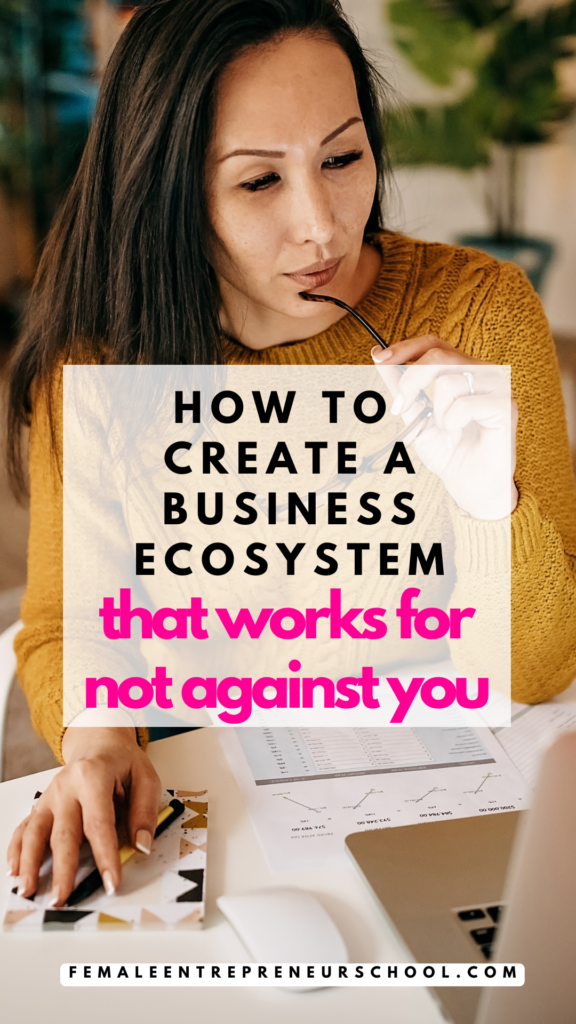How To Build A Business Ecosystem That Actually Works For Not Against You

Most online businesses aren’t failing because the business owners running them are lazy.
They’re failing because the entire setup of those businesses is broken chaos – without the business owner always realising this is so.
Chaos in business can come in all shapes and sizes. Disconnected platforms, no clear path to sales, and a whole lot of posting on social with zero return.
This creates a business that struggles to get any traction at all.
If you’re exhausted from showing up everywhere, and you’ve little to show for your efforts, this post is your turning point.
What you don’t need isn’t another Instagram hack, or to be on yet another social platform.
What you DO need are successful ecosystems in your business.
Ecosystems in your business are essential, and they’re there to ensure that every part of your business plays a key role in your success.
Your business needs to support you properly, not break you slowly but surely over time.
I see too many business owners burning out through poor business models and insufficient ecosystems within that business, as a result they end up closing their businesses for good.
It is not social that is breaking your business. It is your strategy that’s broken. We need to fix that to help you start to see real, tangible results. This is the strategy that I help with.
You’ll have more than one ecosystem in your business. Many will be there to move people from traffic to lead to sale, and that’s exactly what your ecosystems should do.
Your business ecosystems should have the ability to do the heavy lifting of this process for you, so that you don’t have to be online 24/7.
I’ve had ladies in my coaching programmes who’ve been burnt out working 60 hour weeks, feeling that they’re failing even though they are working all the hours.
With a tweak to their strategy, making sure the ecosystems in their business work for and not against them, those ladies have been able to increase yearly revenue, whilst at the same time reducing by a big mile, the weekly hours they work.
Let’s walk through how you build business ecosystems that actually perform for you – and why the way you’ve been showing up in your business is currently keeping you stuck.

So, what is a business ecosystem?
Business ecosystems are the structures that bring people to your business, show them what you do, earn their trust, and then move those people through a journey to a lead and eventually a sale.
An ecosystem is how your Pinterest drives traffic to your blog, and your blog drives traffic to your list, and your list drives traffic to your products/services.
An ecosystem is also how your lead magnet connects to an email sequence and an email sequence connects to a product/service.
It’s how your Instagram stories lead to a ManyChat automation inside DMs that then delivers a freebie, and gently guides someone forwards to a paid offer.
You’ll have many ecosystems in your business, all of which make up your broader business model ecosystem as a whole.
Every ecosystem you have in your business should be optimised to work for you and not against you as much as possible.
Many ecosystems in businesses are broken, or have gaps or bottlenecks so they don’t work well enough to bring the results the business owner wants and needs.
Many times business owners don’t build out individual ecosystems sufficiently enough, and don’t spend enough time marketing those ecosystems to make them effective.
Instead, they fail to see results in the spaces they’re visible and then hop around spaces, jumping from one platform to another, or adding yet another social space in, in the hope that something will work.
There’s no real plan, just more and more content. And it’s exhausting.
Let me show you the difference.
What a broken ecosystem looks like:
- Instagram content being churned out daily and going nowhere.
- Pinterest boards and/or pins that aren’t linked to anything.
- A lead magnet… with zero follow-up sequence.
- Blog posts/podcasts/Youtubes that don’t promote offers.
- A website with no clear journey or next step.
- An Etsy store with products that then don’t lead anywhere else.
All of the above points to a whole lot of effort with no real ecosystem holding it all together.
Now let’s flip that.
What a working ecosystem looks like:
Every platform, every space, everything has a job.
Here’s a quick example of some ecosystems I help my clients build:
Pinterest → Blog → Free Download → Email Sequence → Offer
Instagram → ManyChat Flow → Lead Magnet → Follow-Up Emails → Low-Ticket Product → High Ticket Product
YouTube → Quiz Freebie → Segmented Emails → High-Ticket Offer
This is what a business that works looks like, while you’re walking the dog.
Why most businesses don’t have this in place
If you don’t have ecosystems like this in place right across your business, it’s not your fault. It’s because no one taught you to think like a strategist.
You were taught to post consistently (and burnout). You were taught to engage constantly (and burnout). You were taught to hustle (and end up hating it).
While you were stuck on the content treadmill, your actual business model was quietly burning down.
Here’s what usually goes wrong:
- No absolute clarity on what each of your spaces is supposed to do, likewise for every piece of content you post, no matter where that content is.
- Building incorrectly (starting with trying to create viral reels, instead of offers that work).
- Treating social like it is your business, instead of a surface signpost only.
- Chasing likes instead of leads.
- Overthinking tech, buying all the software, and under-thinking real structure that works.
None of this is your fault. But now you know better, you get to build better, and it’s time to take action with that now.
Interestingly, ladies inside my community go through an ecosystem training with me. They start to map out their ecosystems (something 99% of them have NEVER done before).
As they start to map out all of the ecosystems in their businesses, what they immediately start to see is gaps/bottlenecks.
- They see that they have incomplete ecosystems, and this happens because there are parts of the ecosystem build that they don’t feel confident with, or have failed to complete because they are starters (they like the beginning processes), not finishers (they are bad at completing things).
- They see that they have bottlenecks inside ecosystems (for example, too many steps to get people to take action with them).
- They see that they are creating weak ecosystems (not enough value, or urgency, or scarcity in the ecosystem to encourage people to take action).
Understanding their ecosystems deeply, helps them resolve issues as they identify them, creating much more effective ecosystems for their businesses moving forwards.

How to Build Your Business Ecosystem (Step-by-Step)
1. Choose Your Surface Spaces
These are the core ‘surface’ spaces that form part of your main top level Business Model ecosystem.
For example, this could be your website, blog, Etsy shop, Instagram and Pinterest. They are the spaces people first land when they come across you, and where they go when they want to find out more or buy something.
Your core ‘surface’ spaces are the starting point of most of your ecosystems.
In addition to your core surface spaces, you should also have a couple of other spaces you use to form your top level Business Model ecosystem.
Those spaces are a mailing list and Manychat.
These two spaces combined with your other ‘surface’ spaces give you the ability to have a top level Business Model ecosystem that will help generate much better results for your business.
You will have more ecosystems within this top level ecosystem, all designed to help people connect with you, convert to leads, and convert to sales.
2. Build Your Lead Capture Ecosystem
Once you have your top level Business Model ecosystem in place (1. above), you then start to create smaller ecosystems within that Business Model, all of which are designed to create journeys you take your audience on.
One of those ecosystems will be your lead magnet (or opt-in) ecosystem. You may have more than one of these in place at any time, but a lead capture ecosystem is essential for your success, and you should have this optimised, in place, and be marketing that lead magnet ecosystem regularly.
An example of a lead capture ecosystem is this:
Instagram content promoting a freebie -> Manychat flows in comments and DMS -> delivery of the lead magnet in DMs with Manychat –> adds a lead to your list in Manychat (and your main mailing list too) -> delivery of the lead magnet via email AND inside Instagram DMs to make accessibility easy for the subscriber -> adding to an email nurture sequence that sells -> offered upsell opportunity right inside Instagram DMs with Manychat -> follow up emails to any purchasers -> more opportunities presented to the customer.
More business owners will stop where the bold/italic text stops above – creating an ecosystem that is weak, and does not fully take advantage of the opportunities that ecosystem could provide.
It’s essential that you build your ecosystems out fully, to create more opportunity for both you as the business, and the individual you’re pushing through that ecosystem. This is where most business owners fail, and as a result do not get the results they want and need.
3. Create Full Ecosystems
Take every ‘journey’ you have for your audience, no matter where that journey is. Review it DEEPLY. Look at where you are failing to build out more fully the ecosystem for that journey.
Your social media content, your YouTube episodes, your blog posts, your Pinterest, your emails. Every time you create ANYTHING, ANYWHERE in your business, you should be creating that thing as part of a deep ecosystem.
Every single ecosystem you have has the potential to work more effectively for you than it does right now.
Instead of sending one email as part of your ecosystem, send 5, or 8 as part of a sequence, with an end goal for those emails. Give more value in your emails. Tell your audience what you offer in those emails. Tell them why it matters. And most importantly tell them how to buy.
Instead of using Pinterest to drive to a blog that has free value in it, offer a freebie in the blog that you delivery by way of email, and then put people in an email sequence where you give more value, and you sell. Add a relevant paid product or service to the blog as well – make that ecosystem WORK for you.
4. Map Your Content Backwards
Every post, story, pin, video, blog, podcast, freebie should sit in an ecosystem that creates a longer, broader journey for your audience that somewhere leads to a SALE.
5. Track The Gaps
Forget likes. Instead ask: What ecosystems do I have in place? Are they working effectively? Are there gaps or bottlenecks? Are there steps I can add on the end to improve the ecosystem further? Which ecosystems are working best and how can I create more of the same that will continue to work for me?
Take action. Improve. Create ecosystems that are going to work for your business.
Want some real-world proof around the importance of ecosystems in your business? Let me show you a few client examples.
Carmen (Crochet Designer)
Pinterest → Blog → Free Pattern Download → Email Funnel → Monthly Pattern Sales (five figure business).
Ela (Decluttering Coach)
Facebook → Free Guide → ManyChat Automation → Email Series → Low Ticket Guides -> Higher Ticket 121 Support (now growing faster than every before).
Helen (Textile Artist)
Pinterest → Blog → Freebie -> Email → Book Sale → waiting list for next book (significant increase in book sales for her business).
Different niches. Same strategy.
Your ecosystems don’t need to be perfect.
What they need is purpose. Flow. Connection. Journey.
If it feels like your ecosystems are a jumble right now, that’s okay. That’s where everyone starts.
This week, take an hour and take a step back. Look at what you’ve built. Ask yourself: Do the ecosystems I have in place have a path to sales? Or are they just noise? Do I have ecosystems in place, or am I showing up in a fragmented and disconnected way?
When you review like this, you can then take action to start to map out what needs connecting and correcting with your ecosystems. This is a powerful exercise for your business. And one that should be undertaken regularly. Look for the gaps. Fix them.
Want help building your ecosystem?
Inside my free community 40k Kickstart Hub, there’s a deeper training where I walk through the process of building ever more effective ecosystems for your business.
Building the best ecosystems is such an important and foundational move to make in your business, because when you do this, the results become easier.
If you want the strategy, structure, and sanity to finally get results from your business 40k Kickstart Hub will help you achieve better, faster, more streamlined results. You can join my free 40k Kickstart Hub right here.
Inside you’ll find real strategy. No fluff. And the best business support to help you build a business that works.
Great strategy = better success. Your ecosystems are key to that strategy.
Related Articles
The 40k Revenue Business Model That Actually Makes Sense (And How To Build It)
Unstoppable And Unshakeable In Business
